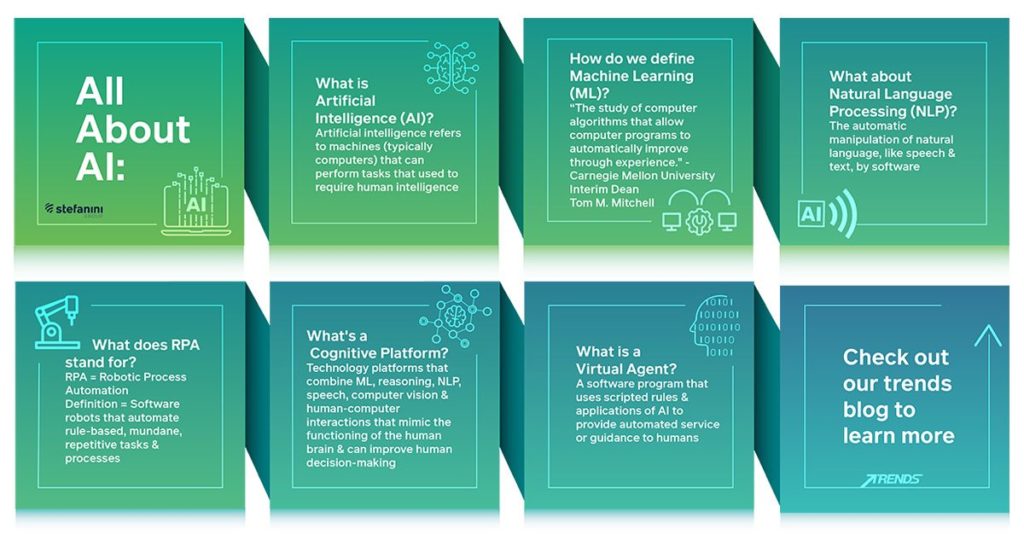What’s the difference between AI, RPA and machine learning solutions like Cognitive Platforms and Virtual Agents? We break down the terms you need to know in this Trends blog!
- What is Machine Learning?
- RPA Definition
- Virtual Agents
- Defining Natural Language Processing
- What’s a Cognitive Platform?
- Meet SAI and Sophie

Click here to download the infographic!
Artificial intelligence has been around since the 1960s – and it has grown so much since then! Indeed, since the early era of room-size computer systems, today’s AI solutions have grown in sophistication, unlocking rapid end-to-end business process automation, digital transformation, and more.
You likely encounter AI – and its siblings, machine learning and virtual assistants – every day. But what makes up AI and how do we know when we’re working with a cognitive platform? Our definitive guide will answer those questions and more.
AI is playing a bigger role in cybersecurity. Get the scoop here!
How Do RPA and Artificial Intelligence Work Together?
AI and robotic process automation (RPA) are both quite similar in that they’re increasingly popular technologies. In fact, more and more enterprises are installing them year after year. Yet, until now, both have been confined to silos within organizations, a move that has required highly skilled — yet limited — practitioners to successfully deploy them.
Now, entities are discovering the intelligent automation that results when AI and RPA are combined.
But, we’re getting ahead of ourselves. First, what’s artificial intelligence? In short, AI systems refer to machines (typically computers) that can perform tasks that typically required human intelligence to accomplish.
What is Machine Learning?
According to Carnegie Mellon University Interim Dean Tom M. Mitchell, machine learning (ML) is “the study of computer algorithms that allow computer programs to automatically improve through experience.” This branch of artificial intelligence relies on working with small to large datasets by examining and comparing the data to find common patterns and explore nuances. Further, the field of data science involves the process of prediction, visualization, analysis, and pre-processing of data.
And the entire “tree” of machine learning is complex. It’s supported by branches like deep learning (which can perform tasks without classic rule-based programming) and various other types of neural networks. Though some companies use AI and ML interchangeably, it’s important to remember that there is a substantial difference between the two. Broadly speaking, AI is a bigger concept that can create intelligent machines that can simulate human thinking capability and behavior. On the other hand, machine learning is an application or subset of AI that allows machines to learn from big data without being programmed explicitly.
RPA Definition
How does RPA fit in? First, let’s point out a needed clarification – the term “robot” in “robotic process automation” doesn’t actually refer to physical or AI robots. According to Automation Anywhere, the term RPA refers to software robots that automate rule-based, mundane, repetitive tasks and processes, which eliminates human error and human intervention and significantly increases productivity and efficiency. Further, RPA deals with structured data while AI gathers insights from unstructured data. Moreover, these bots can copy/cut and paste data, move files and folders, scrape web browsers, fill in forms, and extract data from documents.
Now that we’ve defined both AI and RPA, let’s move onto the real question – how do they work together?
Applying AI to RPA
They might have a lot in common, but it’s important to remember that AI and RPA are two different technologies. While RPA can only do what its programmer instructs it to do, AI is self-learning. When it comes to AI and RPA working together, the application is clear – RPA can automate all rule-based tasks and AI can bridge the gap where RPA falls short.
The following are a few ways AI and RPA can be combined:
- Readmission prediction in healthcare
- Pricing optimization in retail
- Fraud detection in financial services
- Deal guidance in process services
What is AI engineering? Learn more about this Gartner tech trend!
Virtual Agents
While AI and virtual agents – or chatbots – might seem synonymous, they both perform entirely different functions. According to TechTarget, a virtual agent (sometimes called an intelligent virtual agent, virtual rep or chatbot) is a software program that uses scripted rules and applications of AI to provide automated service or guidance to humans.
They are most commonly used in customer service functions to answer routine customer queries, fulfill standard requests and/or handle simple problems. However, they can also handle employee-driven needs like providing help desk-type services within the IT function.
Virtual agents are highly similar to virtual assistants, an application program that understands natural language voice commands and is also deployed to fulfill people’s needs or help them complete tasks.
Defining Natural Language Processing
Natural Language Processing, or NLP for short, is defined as the automatic manipulation of natural language, like speech and text, by software. Why is it important? Broadly, NLP makes it possible for humans to talk to machines. This capability enables machines to make sense of text and perform tasks like translation, grammar checking, or topic classification.
Today, the AI branch is helping companies gain insights from multiple data sources and automating repetitive tasks. For example, a sentiment analyzer can help brands detect emotions in text (like negative social media comments).
What’s a Cognitive Platform?
Also called cognitive computing, this term describes technology platforms that combine machine learning, reasoning, natural language processing, speech, computer vision, and human-computer interactions that mimic the functioning of the human brain and can improve human decision-making. While it may seem similar to AI, AI is concerned with implementing the best algorithm to solve problems while cognitive computing tries to mimic human intelligence and wisdom by analyzing a series of factors.
There are a host of benefits associated with cognitive systems and cognitive computing technology:
- Accurate data analysis – did you know? Cognitive systems are highly-efficient in collecting, juxtaposing and cross-referencing information to analyze a situation effectively.
- Leaner and more efficient business processes – cognitive computing can analyze emerging patterns, spot business opportunities and take care of critical process-centric issues in real time.
- Improved customer interaction – by implementing RPA, cognitive computing can make it possible to provide only relevant information to customers.
Stefanini and IDG are joining forces around the topic of cognitive platforms. Learn more!
Meet SAI and Sophie
Artificial intelligence is no longer a much-anticipated technology of the future. Instead, sci-fi has become a reality. From everyday chatbots to more sophisticated deployments, we interact with AI everyday – often without realizing it.
It’s time to make AI approachable. And with SAI – Stefanini Artificial Intelligence – your business can rest assured that adopting AI is seamless and outcome-focused. From streamlining how your organization operates to enhancing productivity, SAI is here to create new value for your business, with Stefanini serving as the collaborative partner needed for your AI journey.
And with Sophie – Stefanini’s virtual assistant – at your side, you can be confident that your automation needs are being met.
Learn more about Sophie. Speak with an AI expert and learn how our customizable AI solutions can fill in the gaps at your business.



















